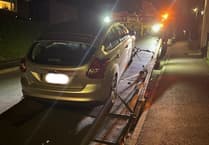LAST Sunday (October 25) marked the 60th anniversary of the Severn Rail Bridge disaster, when five men lost their lives after two barges collided with each other and the 22-span crossing linking Lydney and Sharpness.
Part of the 90-year-old bridge dropped onto the barges, rupturing the gas pipe line it carried and causing the cargo of petrol on one of the craft to catch fire.
The collision in fog and darkness on a swollen river between the Sharpness-bound tankers Wastdale and Arkendale saw the vessels swept past the dock entrance onto a pier of the bridge.
The explosion which followed brought down two spans of the 4,162ft-long crossing, cost five seamen their lives and disrupted school for some two years for dozens of youngsters who travelled daily from Berkeley to Lydney.
The disaster on the night of October 25, 1960, brought stories of dramatic rescues as sailors from the two vessels were thrown into the Severn.
Several spent hours in the water before being found.
Among them, the late George Cooper, of Buckshaft Road, Cinderford, survived for over four hours in the swirling tide before being rescued off Lydney.
Emergency measures included shipping in hundreds of portable gas cookers while special trains had to be introduced to make the journey to Lydney via Gloucester for pupils who used the river crossing to attend Lydney Grammar School.
The deaths of the five men - well known Forest boxer Percy Simmonds, 34; Robert Niblett, aged 25; Jack Dudfield, aged 46; Alex Bullock, aged 40; and 16-year-old Malcolm Hart – weren’t the first fatalities involving the bridge.
During construction, a baulk of timber fell on one man when a rope slipped, and another died when he fell from the part-completed structure, injuring himself on the staging as he fell.
Only a few days after the bridge’s opening, a rowing boat trying to pass underneath was caught in a giant eddy and capsized, with one person drowning.
The trow Brothers was lost after a collision with one of the piers in 1879, and the Victoria, employed in the bridge’s construction, was wrecked in the 1880s.
On February 4 1939, the tanker barges Severn Traveller, Severn Pioneer and Severn Carrier got into difficulties and were carried broadside by the tide onto the bridge.
A connecting hawser snagged one of the piers and the vessels capsized, with six men losing their lives.
The crossing was built in the 1870s by the Severn Bridge Railway Company, primarily to carry coal from the Forest of Dean to the docks at Sharpness.
Until the opening of the Severn road bridge in 1966, it was the furthest-downstream bridge over the Severn.
When the company got into financial difficulties in 1893, it was taken over jointly by the Great Western Railway and the Midland Railway companies.
The bridge continued to be used for freight and passenger services until the 1960 disaster, and saw temporary extra traffic when the Severn Tunnel was closed for engineering work.
Repair work was under consideration when the tanker BP Explorer collided with the bridge the year after the disaster, causing more damage, after which it was decided that it would be uneconomical to repair.
It was demolished between 1967 and 1970, and traces of the wrecks can still be seen at low tide.
Talk of a road crossing linking Lydney and Sharpness has recently been rekindled as part of the Vision 2050 transport plan for Gloucestershire.




